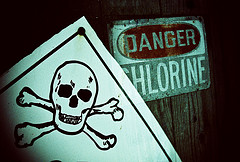The Best and Worst Water For Bromeliads
Author: Melanie Dearringer4 Comments
Care and Culture, Growing Indoors, Growing Outdoors

One of the facts of modern life is that we often don’t know what is in our water. And some of the things we do know about, such as chlorine, are despised by plants. Confined to pots, indoor plants have no way to escape tainted water, so it’s crucial to give them the best possible.
Rainwater
Rainwater is preferred as it is the way plants get their moisture in their natural environment. Simply use a clean container to collect the rain. It is important that you not use a metal container. Damage and even death can occur due to traces of metallic elements passed on through the water. After a good rain, you can transfer water to gallon jugs for convenience and future use.
Purified Water
Distillation, deionization, and reverse osmosis are all methods of achieving purified water. These processes are designed to eliminate almost all types of water impurities. Minerals that your bromeliad requires for optimal growth are also stripped through these processes. So while purified water is safe to use, you should also follow up with some sort of fertilizing plan if you choose this type of water.
Tap Water
 Tap water can contain chemicals, such as chlorine, that are harmful to plants. Plants that are grown indoors are especially susceptible because without the presence of rain to wash away the chemicals found in tap water, they are left to build up in the container. Your bromeliad can also be affected by the hardness of your tap water. When using a water that contains high mineral levels, the minerals can form what looks like a white crud on your bromeliads leaves. This deposit can cause injury to your bromeliad’s leaves. Soft leaved bromeliads are at a higher risk of damage as a result of hard-water usage.
Tap water can contain chemicals, such as chlorine, that are harmful to plants. Plants that are grown indoors are especially susceptible because without the presence of rain to wash away the chemicals found in tap water, they are left to build up in the container. Your bromeliad can also be affected by the hardness of your tap water. When using a water that contains high mineral levels, the minerals can form what looks like a white crud on your bromeliads leaves. This deposit can cause injury to your bromeliad’s leaves. Soft leaved bromeliads are at a higher risk of damage as a result of hard-water usage.
If you must use tap water, it is recommended that you allow the water to sit out for 24 hours to allow time for chemicals, like chlorine to dissipate. If you make a habit of refilling your watering containers each time you finish your watering maintenance, gases will slowly escape and the water will be ready to use by the time your plants need watering again.
Softened Water
Avoid soft water. While water softeners are great at removing the hardness in your water, the sodium levels it leaves behind are extremely harmful to your bromeliad.
Regardless of its source, it is important to make sure water is at room temperature when you give it to your plants. Giving cold water to tropical plants can chill their roots and cause them to rot.
Sources
Mavea Inspired Water http://www.inspiredwater.org/2010/10/watering-plants-filtered-water
Bromeliad Society International http://www.bsi.org/new/
Chlorinated Danger photo credit: Cameron Russell via http://www.flickr.com/photos/camkage/5135679647/
Rainfall (Suffocate) Photo credit: Sinead McKeown via http://www.flickr.com/photos/ilovesunshine/5948804485/
4 Responses to “The Best and Worst Water For Bromeliads”
Leave a Reply

Resource Download
Hechtia Care Cheat Sheet
Learn how to care for your Hechtia bromeliad with this quick and easy informational guide.
Learn More
Ask an Expert
Questions about bromeliads?
Our experts love a challenge!
Photo of the Week
Submit your photo to be featured on the blog!
More Photo of the Week Winners
Submit Photo








Cud i give my plants the A.C water ????
I have hard water and it leaves white marks and crust on the leaves. Is there any way to remove it?
dont use hard water simple as that
Tap water is best.